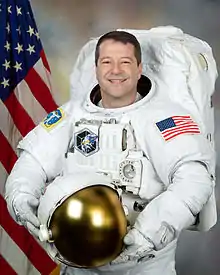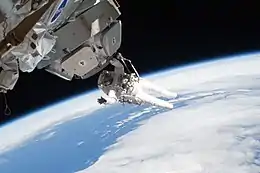Nicholas Patrick
Nicholas James MacDonald Patrick, Ph.D. (born 19 November 1964), is a British-American engineer and a former NASA astronaut. His flight on the 2006 Discovery STS-116 mission made him the fourth person born in the United Kingdom to go into space.[2]
Nicholas Patrick | |
|---|---|
 | |
| Born | 19 November 1964 Saltburn-by-the-Sea, North Riding of Yorkshire, England |
| Status | Retired[1] |
| Nationality | British / American |
| Alma mater | Trinity College, Cambridge (MA) Massachusetts Institute of Technology (MS, PhD) |
| Occupation | Engineer |
| Space career | |
| NASA Astronaut | |
Time in space | 26d 14h 52m |
| Selection | 1998 NASA Group |
| Missions | STS-116, STS-130 |
Mission insignia | |
Personal life
Patrick was born in Saltburn-by-the-Sea in the North Riding of Yorkshire, England, in 1964 to Gillian and Stewart Patrick.[3] His mother came from the Isle of Skye in Scotland.[4] He grew up in both London and Rye, New York, and eventually became a United States citizen in 1994. Patrick is married to a paediatrician originally from Peru and has three children.
Education and early career
Patrick was first educated at Harrow School and Trinity College, Cambridge (receiving an undergraduate degree in Engineering in 1986). During his university years, he learned to fly as a member of the Royal Air Force's Cambridge University Air Squadron. After Cambridge, he worked for four years as an engineer for the Aircraft Engines Division of General Electric, in Lynn, Massachusetts in the United States.
Patrick then attended the Massachusetts Institute of Technology, receiving a master's degree (1990) and a PhD. (1996), both in Mechanical Engineering. Afterwards, he joined Boeing's Commercial Airplane Group in Seattle.
Space career
NASA career

Patrick was selected by NASA as an astronaut candidate in June 1998 and reported to NASA's Johnson Space Center (JSC) for astronaut training in August 1998. His initial training included scientific and technical briefings, intensive instruction in Shuttle and International Space Station systems, and physiological, survival, and classroom training in preparation for T-38 flight.
Patrick has logged over 308 hours in space, having completed his first space mission as a member of the crew of STS-116 – a construction and logistics mission to the International Space Station. He occasionally serves as a CAPCOM; for example, he worked with the Orbit 2 team for STS-120.
Patrick notably put the finishing touches on the Tranquility node during STS-130.[5]
In July 2004, Patrick served as an aquanaut during the NEEMO 6 mission aboard the Aquarius underwater laboratory, living and working underwater for ten days.[6] In August 2007, he served as the commander of the NEEMO 13 mission, living underwater for another ten days.[7]
Patrick retired from the NASA Astronaut Corps in May 2012.[1]
NASA Spaceflight Experience
STS-116 Discovery ( 9–22 December 2006): The seven-member crew on this 12-day mission continued construction of the ISS outpost by adding the P5 spacer truss segment during the first of four spacewalks. The next two spacewalks rewired the station's power system, preparing it to support the addition of European and Japanese science modules by future shuttle crews. The fourth spacewalk was added to allow the crew to coax and retract a stubborn solar panel to fold up accordion-style into its box. Discovery also delivered a new crew member and more than two tons of equipment and supplies to the station. Almost two tons of items no longer needed on the station returned to Earth with STS-116. Mission duration was 12 days, 20 hours and 45 minutes.
Owing to both his Scottish ancestry and his endorsement of the Careers Scotland Space School, Patrick requested a Scottish flag that had been flown at the Scottish Parliament to go with him on STS-116 Discovery.[4] It is now kept on display at the National Museum of Scotland in Edinburgh.[4]
STS-130 Endeavour (8 to 21 February 2010): This mission launched at night, carrying the International Space Station's final permanent modules: Tranquility and Cupola. Tranquility (or Node 3) is now the life-support hub of the station, containing exercise, water recycling, and environmental control systems, while the Cupola provides the largest set of windows ever to grace a spacecraft. These seven windows, arranged in a hemisphere, provide a spectacular and panoramic view of our planet and a direct view of station robotic operations. During the 13-day, 18-hour mission, Endeavour and her six-member crew traveled more than 5.7 million miles and completed 217 orbits of the Earth, touching down at night at Kennedy Space Center, Florida.
Blue Origin career
Patrick joined Blue Origin in 2012.[8] Patrick currently works as a human integration architect at Blue Origin.[9]
References
- "NASA Astronauts Kenneth Ham and Nicholas Patrick Leave Agency". NASA. 15 June 2012. Retrieved 19 June 2012.
- "The seven Britons to go to space". BBC. 15 December 2015.
- https://www.nasa.gov/sites/default/files/atoms/files/patrick_nicholas.pdf
- Scottish Government. "Scottish Parliament space mission saltire flag lands with National Museums Scotland". Retrieved 15 October 2013.
- "ISS crew in third spacewalk to fit new Tranquility Node". BBC News. 17 February 2010. Retrieved 17 February 2010.
- NASA (3 August 2004). "NEEMO 6". NASA. Retrieved 23 September 2011.
- NASA (24 July 2007). "NASA Announces Next Undersea Exploration Mission Dates and Crew". NASA. Retrieved 23 September 2011.
- Taylor Soper (20 November 2012). "Veteran NASA astronaut Nicholas Patrick joins Blue Origin as human integration architect". GeekWire.
- Calla Cofield (22 June 2015). "Blue Origin Offers Tantalizing Preview of Private Space Trips (Video)". SPACE.com.